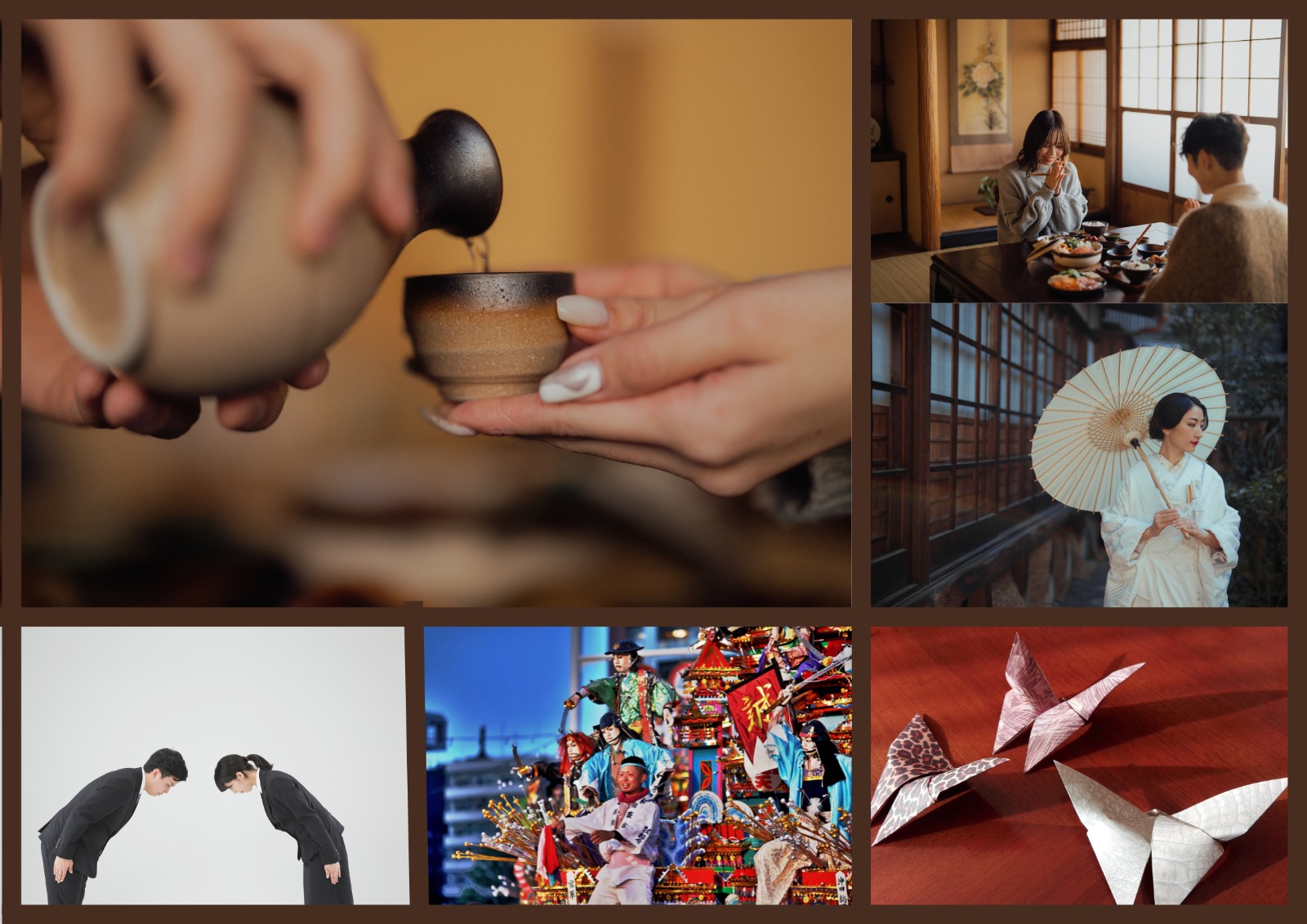Japanese customs encompass many aspects of daily life, from traditions and ceremonies to etiquette. Examples include bowing as a greeting, the tea ceremony, wearing a kimono, and the tradition of Hanami (cherry blossom viewing).
Interesting Customs:
- Bowing
Bowing as a form of greeting and respect is an important part of Japanese culture. Bowing, or ojigi (お辞儀), is not just a physical gesture, but also a sign of respect and humility. The depth of the bow indicates the level of formality and respect to others.
- Tea Ceremony (Sadou):
The Japanese tea ceremony, also known as "chanoyu" or "sado," is a ritual involving the preparation and serving of powdered matcha green tea in a highly formal and meaningful manner. This ceremony is more than just drinking tea; it is an artistic and spiritual experience emphasizing simplicity, harmony, and respect for nature
- Kimono :
Kimonos are traditional Japanese clothing worn on special occasions. They are typically worn for important events and have specific rules. Kimonos are often worn for formal ceremonies such as weddings, tea ceremonies, and traditional festivals, and have deep philosophical meanings in their designs and symbolic motifs.
- Hanami :
Hanami is a Japanese custom that celebrates the beauty of cherry blossoms by enjoying the scenery and picnicking under cherry trees. Hanami, which means "flower viewing," is an ancient tradition where people gather to enjoy the blooming cherry blossoms, especially in spring.
- Matsuri :
Matsuri are traditional Japanese festivals filled with color and joy. Matsuri are celebrated to honor deities, commemorate important events, or recognize a particular season. These celebrations typically involve processions, floats, dancing, music, and various other events aimed at entertaining and strengthening social bonds within the local community.
- Origami :
The Japanese art of paper folding has become both a form of entertainment and an educational tool. Origami, the Japanese art of paper folding, plays an important role in Japanese customs. In the past, origami was often used in religious rituals and as a symbol of respect at important events such as weddings and religious ceremonies.
Origami is believed to have originated in Japan during the Heian period (741-1191), and was originally used as a lid for wine or sake bottles during worship ceremonies. Over time, origami became a symbol of good fortune and honor, and is often used in Shinto religious ceremonies.
- Geisha :
Geisha are Japanese women who entertain with various traditional arts such as dance, music, and conversation. They are considered protectors of traditional Japanese culture and arts and play a vital role in preserving these traditions.
- Onshen :
Onsen (温泉) is a Japanese term referring to hot springs and baths with hot water sourced from within the earth. Onsen is a popular tourist attraction in Japan, often used for relaxation, unwinding, and even for health treatments.
- Tako :
Tako are traditional Japanese kites often used as decorations at special events. In Japan, kites (tako) have strong cultural significance. Flying kites (takoage) is a favorite Japanese family activity, especially during the New Year. Kites in Japan are often made of washi paper, with bamboo or cypress frames.
- Hanabi :
Hanabi (花火) is the Japanese term for "fireworks." They are an important part of Japanese culture, especially in the summer, with popular fireworks festivals (hanabi taikai).
- Itadakimasu :
A phrase said before starting a meal, as an expression of gratitude for the food.
- Maintaining Cleanliness
Maintaining cleanliness is an integral part of Japanese culture, practiced from an early age and is a shared responsibility. Japanese society is known for its discipline in disposing of trash, cleaning the environment, and maintaining order.
- Walking
Walking is an integral part of Japanese daily life. Walking more than 10,000 steps a day is very easy for Japanese people.
Numerous studies have shown the benefits of walking, one of which is a longer lifespan. A recent study conducted by Kyoto University found that the habit of walking among Japanese people is closely linked to a reduced risk of death
- Taking a Warm Bath at Night
Taking a warm bath at night is a common tradition in Japan, often taken in places like onsen (natural hot springs) or ryokan (traditional inns). In addition to cleansing the body, a warm bath also has benefits such as relaxing muscles, improving blood circulation, and promoting restful sleep
- Wearing a Mask When Sick
Wearing a mask when sick is a sign of consideration for others and prevents the spread of disease.
- Removing Shoes When Entering a Home
Removing shoes when entering someone else's home is a sign of respect and maintains the cleanliness of the home. However, removing your shoes before entering a home in Japan is a very common and important custom in their culture. This custom is called "genkan" and aims to maintain the cleanliness of the house, especially the tatami area.
Tatami is a traditional Japanese flooring made of rice straw. Tatami floors can easily become dirty and damaged if not kept clean, so removing your shoes is a way of showing respect for the floor.
- No Handshakes/Hugs
Shaking hands is not a common form of greeting, especially among strangers in Japan. It is more common to bow as a sign of respect. However, handshakes are acceptable in international business contexts or when meeting strangers
- Mutual Bowing
Mutual bowing as a form of greeting is a common practice in Japan known as "Ojigi" and is an important part of Japanese culture and etiquette. Ogiji are used as a form of greeting, gratitude, or an expression of respect and apology. There are different types of Ogiji used depending on the situation and level of formality.
Data Source: Rhike Resty














